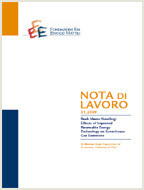The Critical Mass Approach to Achieve a Deal on Green Goods and Services: What is on the Table? How Much to Expect?

25.08.2014
Jaime de Melo, Mariana Vijil
F18, Q56
Environmental Goods, Environmental Services, Doha Round, APEC, Davos Initiative, Tariff Reductions
Climate Change and Sustainable Development
Carlo Carraro
At the Davos forum of January 2014, a group of 14 countries pledged to launch negotiations on liberalising trade in ‘green goods’ (also known as `environmental goods’(EGs)), focussing on the elimination of tariffs for an ‘APEC list’ of 54 products. The paper shows that the ‘Davos group’, with an average tariff of 1.8%, has little to offer as countries have avoided submitting products with tariffs peaks for tariff reductions. Even if the list were extended to the 411 products on the ‘WTO list’, taking into account tariff dispersion, their tariff structure on EGs would be equivalent to a uniform tariff of 3.4%, about half the uniform tariff-equivalent for non EGs products. Enlarging the number of participants to low-income countries might be possible as, on average, their imports would not increase by more than 8 percent. However, because of the strong complementarities between trade in Environmental Goods and trade in Environmental Services, these should also be brought to the negotiation table even though difficulties in reaching agreement on their scope are likely to be great.
***
Suggested citation: de Melo, J., M. Vijil, (2014), ‘The Critical Mass Approach to Achieve a Deal on Green Goods and Services: What is on the Table? How Much to Expect?’, Nota di Lavoro 70.2014, Milan, Italy: Fondazione Eni Enrico Mattei.
